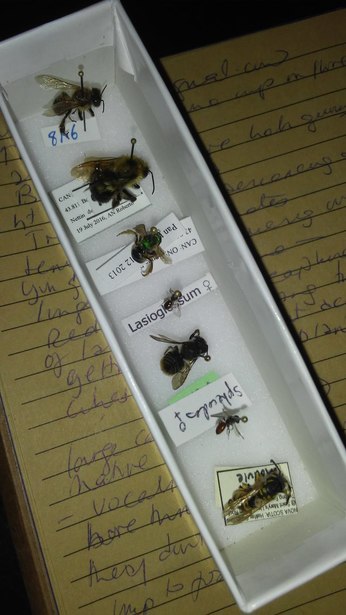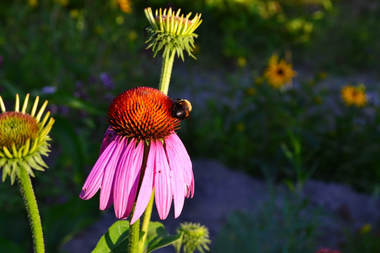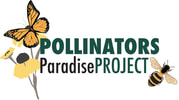 Bees: Samples Bees: Samples Scott MacIvor makes me want to care for wild bees. I mean really care. In his April 9th lecture--entitled Wild-bee Diversity and Pollination Services: Are Cities a Refuge?--given at RBG for the Hamilton Naturalists' Club, Scott who is a bee expert and an Assistant Professor at the University of Toronto Scarborough in the Department of Biological Sciences, spoke about the specific needs of wild bees of our cities. Scott's tender love of bees was contagious as he described the lives of these industrious little creatures apart from ours, doing their bee thing; their relationships--they have beautiful, complicated and unique relationships!--with their own special flowers. The poetry of it all: how flowers have evolved nectar, scent and oil essence because they are trying to attract their favourite bees. Bees are positively charged while pollen is negatively charged. There's this technique used by some bees called "buzz pollination" or sonication, to release pollen which is firmly held by the anthers that is a fast, effective, interaction with the flower in point. And only bigger bees can open certain kinds of flowers. "Bees and flowers communicate with each other," Scott said. Some bees, like the Carpenter bee, will vocalize to flight. "And for each flower, there is a different suite of bees, that is, flowers have a community of bees that they prefer." "In the same way, different bees have different affinities for flowers, different interactions scaffolding one another. There's a mutualism in action." Think of that! Most wild bees are solitary-- they live on their own. Female bees work to exhaustion, work to death, males mate and die. Yep. Sounds about right. What's more, each female is her own queen. I like that a lot. Some other interesting facts that Scott shared: Bees are more related to their sisters than to their offspring. Wild solitary bees are active only for a few weeks in the year, adults are very short-lived, one generation per year. "They have evolved to be active for their favourite flowers," Scott said. "They go find that beautiful dark cavity to build their rooms, all the males in the front, to die, all the females in the back because they are more important. Imagine a mason bee, waiting in a grass stem waiting, waiting for that one cue: warmth." With his presentation, Scott invited us, we people of the Golden Horseshoe, to plan our spaces for solitary wild bees. His lecture was an invitation to consider how our designs, here in the city, might influence our decision making for supporting bee diversity.
3 Comments
 This piece was recently posted in the Wood Duck April 2018 Toronto has a Pollinator Protection Strategy (PPS) in the works. I chatted with some of the people responsible for its creation to get a “behind the scenes look,” as well as thoughts on how we can do something similar in Hamilton. Annemarie Baynton, Senior Environmental Planner at the City of Toronto is the lead on the initiative, and coordinates the various divisions responsible for implementation elements of the strategy. Annemarie points to a long history in Toronto of municipal and non profit groups and the Toronto and Region Conservation Authority (TRCA) working to protect pollinators and enhance habitat. “Our Parks division has been leading the way in habitat creation, enhancement and restoration for decades,” she says. Another influence for the PPS was Bees of Toronto, one of the City’s free Biodiversity Booklet Series that came out and was very popular with the general public. “So we wanted to bring this interest and the work already being done under a comprehensive structure,” Annemarie says. That structure is the City of Toronto’s broader Biodiversity Strategy, (also in draft form)** and the PPS will be one of its components. In developing the PPS, an advisory group was set up in 2016 of scientists and researchers, students and other academics, pollinator and native plant experts, and community based groups to provide guidance to the City on pollination protection and the development of proposed actions. Annemarie says that the Pollinator Health Action Plan “was helpful and a good starting point, with one of its major goals being to restore, enhance and protect one million acres of pollinator habitat in Ontario.” Together with the expert panel and sub groups, they came up with recommendations and actions, and then took the draft to the community for feedback. Over 7000 people provided feedback to the draft. It will be going to Council later this year. |
Archives
December 2023
Categories |
|
|
Butterflyway Hamilton: www.facebook.com/butterflywayhamilton/
Environment Hamilton: https://www.environmenthamilton.org/ Hamilton Naturalists' Club: https://hamiltonnature.org/ |

 RSS Feed
RSS Feed